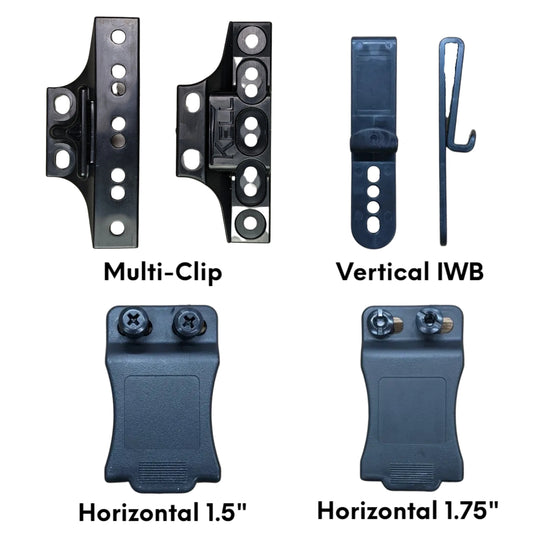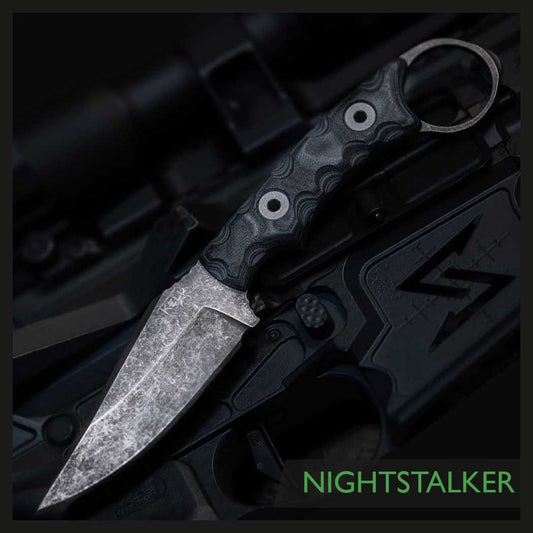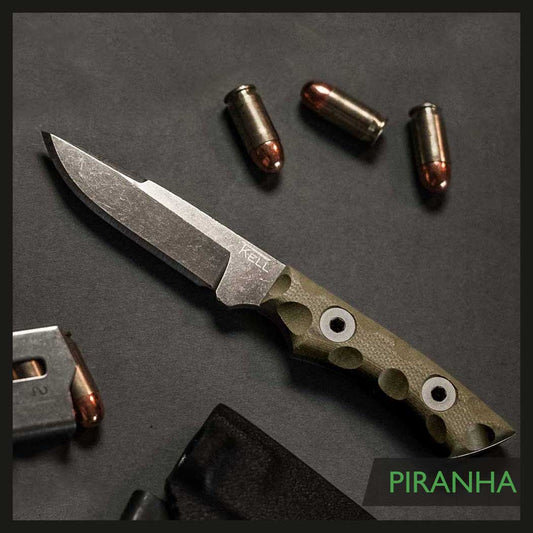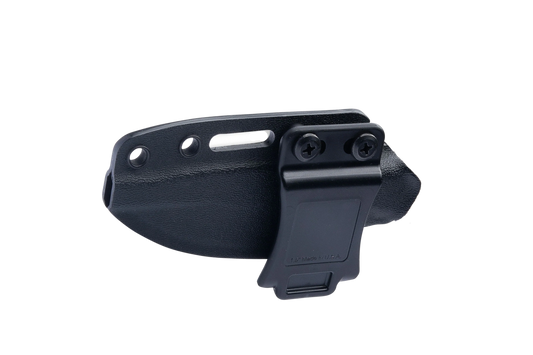Unlike folding knives, fixed blade knives feature a solid design without any moving parts. This makes them stronger, more durable, and less prone to malfunction during heavy-duty outdoor use. Their larger size provides increased cutting power and leverage, making tasks like processing firewood or field dressing game easier and more efficient.
In addition to their practicality, fixed-blade knives are often more legally sound compared to folding knives in many jurisdictions. With their robust construction and straightforward design, they are a sensible choice for law-abiding citizens who need a reliable tool for various purposes.
In this comprehensive guide, we will dive into the benefits of carrying a fixed-blade knife and explore ten practical ways to carry them. Whether you're an experienced user or new to the world of fixed-blade knives, this guide will equip you with the knowledge you need to make the most out of your gear.
Key Takeaways:
- Fixed-blade knives are prized for their durability, reliability, and straightforward design.
- They offer greater cutting power and leverage compared to folding knives.
- Fixed-blade knives are often more legally permissible in many jurisdictions.
- There are various ways to carry a fixed-blade knife, from waist sheaths to tactical thigh rigs.
- A solid understanding of the parts of a fixed-blade knife and safety protocols is essential for safe and efficient use.
Why You Should Carry a Fixed Blade Knife
There are five key reasons why you should consider carrying a fixed-blade knife:
- Strength and Durability: Fixed-blade knives are incredibly strong and durable, thanks to their full-tang construction and lack of moving parts. This makes them reliable tools that can handle heavy-duty tasks without the risk of failure.
- Reliability: Unlike folding knives, fixed blades offer greater reliability because they don't have any components that can malfunction. They are built to withstand rugged conditions and maintain their performance.
- Cutting Power and Leverage: With their larger size, fixed-blade knives provide greater cutting power and leverage. This makes them ideal for tasks like processing firewood or field dressing games, where precision and strength are crucial.
- Quick Access: Fixed blades can be drawn and put to use within seconds, unlike folders that require opening. This quick access can be a lifesaver in emergency situations or for self-defense, where every second counts.
- Legal Practicality: Fixed-blade knives are subject to fewer legal restrictions in many jurisdictions, making them a practical choice for law-abiding citizens. They offer versatility and functionality without the constraints of certain folding knife regulations.
Carrying a fixed-blade knife ensures that you have a reliable and versatile tool by your side, capable of handling various tasks with ease and confidence.
How to Carry a Fixed Blade Knife
Carrying a fixed-blade knife conveniently and securely is essential for any outdoor enthusiast or adventurer. There are various ways to carry a fixed blade knife, each offering unique advantages and considerations. Whether you're hiking, hunting, or simply enjoying the great outdoors, finding the right carry method ensures quick and easy access to your trusted blade. Here are 10 practical ways to carry a fixed-blade knife:
-
Waist or Belt Sheath: The most common and straightforward method, a waist or belt sheath, keeps the knife securely and conveniently stowed on your hip or behind the pocket. This method allows for easy access and comfortable carry during outdoor activities.
-
Neck Knife Sheath: For those seeking minimalist and unobtrusive carry, a neck knife sheath is an excellent choice. This carry method allows for discreet carrying around the neck, keeping the knife easily accessible when needed.
-
Shoulder Harness Sheath: Carrying full-size fixed-blade knives or other large tools can be done effortlessly with a shoulder harness sheath. This method evenly distributes the weight of the knife, providing comfort and accessibility.
-
Ankle Sheath: An ankle sheath offers concealed carry on the ankle, making it an ideal choice for those who prioritize discreetness. This method ensures easy and quick access to the knife when required.
-
Boot Sheath: Utilizing the space inside a boot for concealed carry, a boot sheath is an effective option. This method keeps the blade hidden and secure, allowing for comfortable movement during outdoor activities.
-
Backpack Straps: Mounting a sheathed knife on backpack straps provides easy access while keeping the knife within immediate reach. This method is particularly useful for hikers and campers.
-
Inside the Waistband (IWB) Sheaths: Offering concealed carry under clothing, IWB sheaths are an excellent choice when discreetness is paramount. This method keeps the knife hidden and easily accessible.
-
Chest Mount Harness: For even greater concealment, a chest mount harness allows for discreet carry of a fixed-blade knife. This method keeps the knife inconspicuous while providing quick access.
-
Tactical Thigh Rigs: Designed specifically for law enforcement and military personnel, tactical thigh rigs offer secure and accessible carry options. This method ensures tactical readiness and quick deployment when required.
-
Off-Body Carry: In situations where discreet carry is necessary, off-body carry provides a viable option. This method allows for discreet stowing of the knife in restricted environments.
Each carry method offers unique advantages, and the choice ultimately depends on personal preference, the nature of the activity, and the level of concealment required. It's important to consider comfort, accessibility, and practicality when selecting the right carry method for your fixed-blade knife.
Understanding the Parts of a Fixed Blade Knife
To truly appreciate the construction and functionality of a fixed-blade knife, it's essential to understand its basic components. A fixed-blade knife consists of five main parts: the blade, tang, handle, guard, and pommel.
- Blade: The blade is the most crucial part of a fixed-blade knife. It is the sharp cutting edge responsible for various cutting tasks. Fixed blades offer superior strength and durability compared to folding knives, making them ideal for heavy-duty use.
- Tang: The tang is the portion of the blade that extends into the handle of the knife. It provides stability and strength, ensuring the blade is securely attached to the handle.
- Handle: The handle, also known as the grip, is the part of the knife that is held during use. It provides comfort, control, and a secure grip while handling the knife.
- Guard: The guard is a protective barrier positioned between the blade and handle. It prevents your hand from slipping onto the blade during use, enhancing safety and providing better control over the knife.
- Pommel: The pommel is the end of the handle opposite the blade. It serves multiple purposes, including balance optimization, striking, and hammering. The pommel can be solid or designed with a lanyard hole for additional utility.
Understanding these different parts of a fixed-blade knife not only deepens your knowledge of its construction but also allows you to select a knife that best suits your needs and preferences.
Safety Protocols for Using Fixed Blade Knives
Safety should always be the top priority when handling fixed-blade knives. Follow these safety protocols to ensure safe use:
- Keep the blade sharp: A sharp blade requires less force and reduces the risk of accidents.
- Use a proper grip: Hold the handle securely but not too tightly to maintain control.
- Always point the knife away: Direct the blade away from your body and others at all times.
- Use a sheath when not in use: Store the knife in a sheath to prevent accidental cuts when not in use.
- Be aware of the blade's location: Avoid contact with your body and other objects while handling the knife.
- Use only one hand: When using and storing the knife, use one hand on the handle and one hand on the sheath for control and safety.
- Stay vigilant and focused: Maintain concentration while using the knife to prevent accidents.
By following these safety protocols, you can ensure the safe and responsible use of fixed-blade knives.
What Will You Use It For? Applications of Fixed Blade Knives
When choosing a fixed-blade knife, it's essential to consider its intended purpose. Fixed blades have a wide range of applications, making them versatile tools for various outdoor activities. Whether you're a survivalist, a hunter, a bushcraft enthusiast, or someone in need of an everyday carry (EDC) knife, there's a fixed-blade option for you.
Survival Knives
Survival knives are designed to be robust and versatile, capable of handling various tasks in challenging environments. They typically feature a strong blade, allowing you to perform cutting, chopping, and prying tasks. Additionally, survival knives often have a versatile design, with features such as a sawback edge, a gut hook, or a firestarter built into the handle.
Hunting Knives
Hunting knives are specifically designed for field dressing and processing game. They have a sharp and sturdy blade to ensure clean and efficient skinning and meat preparation. A good hunting knife should be able to handle the tasks required for dressing game, such as skinning, gutting, and separating joints.
Bushcraft Knives
Bushcraft knives are essential for woodcraft tasks in outdoor settings. They are designed to handle carving, chopping, and other tasks related to wood processing. Bushcraft knives often have a strong, thick blade, providing stability and control for intricate carving tasks. They should also have a comfortable handle, ensuring a secure grip during demanding tasks.
Tactical Knives
Tactical knives are designed for military and law enforcement personnel, as well as anyone in need of a versatile and reliable self-defense tool. They typically feature a strong and durable blade, capable of piercing and slashing with ease. Tactical knives often have an ergonomic handle for a secure grip and quick deployment mechanisms for swift action in high-pressure situations.
Everyday Carry (EDC) Knives
EDC knives are compact and easy to carry, making them ideal for day-to-day tasks. They are designed to be practical and versatile, allowing you to handle everyday cutting and utility needs. EDC knives often have a folding design, with a small blade length that complies with legal carry restrictions in many jurisdictions.
Conclusion
Fixed-blade knives are essential tools for any outdoor enthusiast, offering versatility and reliability in various activities. With the right carry system, your fixed-blade knife can be conveniently and securely stowed, ensuring easy access when needed.
By understanding the benefits of fixed-blade knives, such as their durability and quick access, you can make an informed decision on the best tool for your needs. Additionally, learning about the different ways to carry these knives provides options for practical and discreet carry in any situation.
While enjoying the functionality of fixed-blade knives, it is crucial to prioritize safety. Adhering to safety protocols like maintaining a sharp blade, using the proper grip, and pointing the knife away from your body and others will help prevent accidents and ensure safe usage.
Ultimately, a well-maintained fixed-blade knife can serve as a trusted companion for years to come. Whether you require a knife for survival, hunting, bushcraft, tactical purposes, or everyday carry, choosing the right fixed-blade knife and taking care of it properly will ensure its longevity and effectiveness.
FAQ
Why should I carry a fixed blade knife?
Carrying a fixed blade knife offers several benefits, including their strength and durability, reliability, greater cutting power and leverage, quick access, and fewer legal restrictions in many jurisdictions.
What are the practical ways to carry a fixed blade knife?
There are various ways to carry a fixed blade knife, including waist or belt sheaths, neck knife sheaths, shoulder harness sheaths, ankle sheaths, boot sheaths, backpack strap mounts, inside the waistband (IWB) sheaths, chest mount harnesses, tactical thigh rigs, and off-body carry.
What are the basic components of a fixed blade knife?
The basic components of a fixed blade knife include the blade, tang, handle, guard, and pommel. The blade is the cutting edge, the tang extends into the handle, the handle is the gripping area, the guard is a safety barrier, and the pommel is the end of the handle opposite the blade.
What safety protocols should I follow when using a fixed blade knife?
To ensure safe use of a fixed blade knife, it's important to keep the blade sharp, use a proper grip, point the knife away from your body and others, use a sheath when the knife is not in use, be aware of the blade's location, use only one hand on the handle, and stay vigilant and focused while using the knife.
What are the applications of fixed blade knives?
Fixed blade knives can be used for survival, hunting, bushcraft, tactical, and everyday carry (EDC) purposes. Each application requires a specific design and features to meet the intended use.







